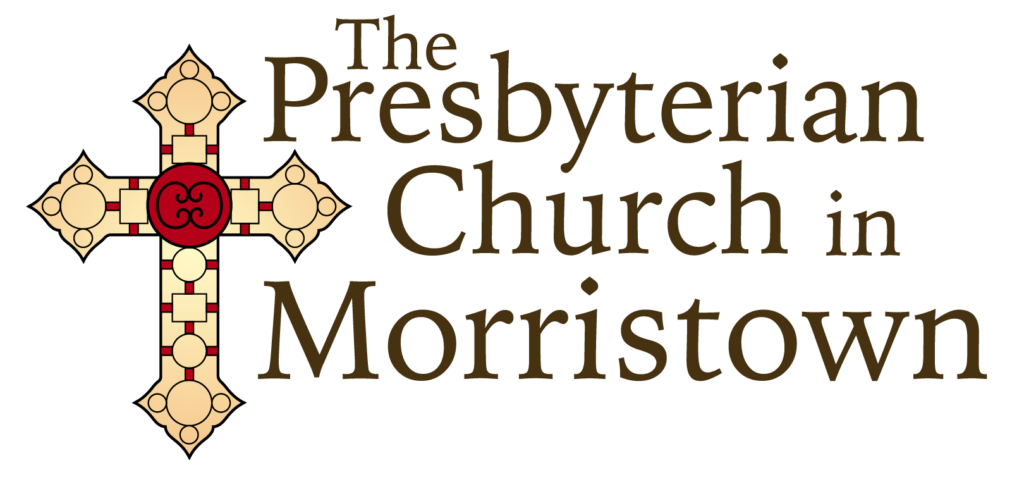Location #5
Midpoint of the path from the north entrance gate to the rear of the graveyard
On the right of the path is a stone marker placed by The Daughters of the American Revolution in memory of Revolutionary Soldiers buried in the cemetery in 1777. Although periodic surveys of grave markers and church records have resulted in the identification of over 1,500 individuals who have been interred in the graveyard, at least one account mentions the number 4,000. During the small pox epidemic of 1777, it is known that there was at least one mass burial of 150. Many years later, workers constructing a burial vault unearthed a variety of brass buttons and fragments of blue uniforms. This memorial is a lasting tribute to those who served and whose resting place in the graveyard today is unmarked.
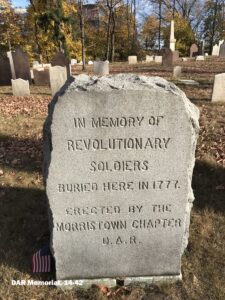
Nearby, is the resting place of John Gwinnup. In 1775, John, a hatter by trade, bought property in “The Hollow” at the corner of Spring and Water Streets from the L’Hommedieu’s for his home and shop. He went on to serve as a Private in the Morris County Militia and died of a fractured skull in January 1777. John’s widow Rachel later married John Stephenson. John and Rachel operated a general store at the site in “The Hollow” for many years. The house was replaced in the 1820s. The 1820 house was moved to Speedwell Village in 1969 and replaced on the site by The Union Baptist Church.
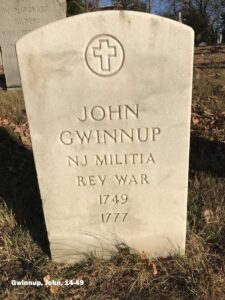
Toward the rear of the cemetery on the right side of the path is the Johnes Family Plot with its memorial to Reverend Timothy Johnes, who served the Congregation faithfully for over 50 years, including the days of the American Revolution. During the small pox epidemic of 1777 Reverend Johnes took an active role in encouraging the citizenry to be inoculated against the disease. The distinctive green plaque was placed by his great great granddaughter, Elizabeth Little sometime after Timothy’s remains were relocated to Evergreen Cemetery in 1876. The re-interment is said to have been at the request of his second wife’s family, in order that she might be reunited with other family members. A likeness of Reverend Timothy Johnes appears on the former department store on the Green.
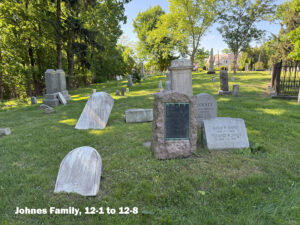
Nearby, on the same side of the path, is the iron fenced plot of the Phoenix Family. One of those buried in the plot is Daniel Phoenix, Jr., who operated a distillery in Washington Valley on School House Lane across from “The Old School House.” The property, later owned by long-time church members Dr. and Mrs. Anson Perina, came to be known as “Still Hill” and is thought to be the birthplace of “Jersey Lightning.” The Phoenix family went on to build and operate a hotel and tavern in Mendham that today serves as the Mendham Town Hall. Cato, who served the family so faithfully for nearly forty years, rests just outside the iron fence.

Closer to the front of the burying ground, on the opposite side of the path is the King Family Plot. At the rear of the enclosure is the brownstone marker of Frederick King. He served as an “Express Rider” during the Revolution and went on to become Morristown’s first Postmaster. Along the right side of the enclosure is the grayish white marker of Frederick’s son Henry King. Henry was Morristown’s second Postmaster.
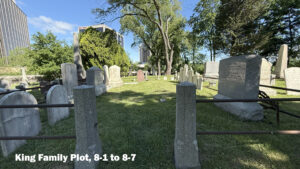
Behind the King and Davis Family Plots is the Vail Family Plot. The large gray obelisk marks the resting place of George Vail. George was a silent partner in his brother Alfred’s efforts to develop the Telegraph with Samuel F. B. Morse. George went on to serve two terms in the United States Congress. His home, “The Willows,” still stands on Speedwell Avenue above Speedwell Lake. Nearby are the graves of Davis Vail and his wife Hannah More Vail. She was a great granddaughter of John and Elizabeth Freeman Ford. In addition, Hannah and Davis were the parents of Stephen Vail and grandparents of Alfred and George Vail. Although he is buried in St. Peter’s Church Yard, Alfred Vail deserves special mention for creating a lasting record of those buried in this cemetery. Following his retirement in 1849, Alfred, who once was under the care of the Women’s Association of the Church in preparation for a career in the ministry, undertook the task of writing a history of the Vail Family in America. In the Spring of 1851, as a part of that effort, he prepared a record of inscriptions on all the markers in the graveyard. Given the perishable nature of tombstone over time, he is owed a tremendous debt of gratitude by succeeding generations.
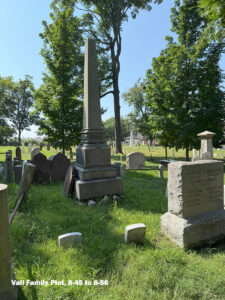
On the right of the path closer to the gate is the Johnson Family Plot including markers for Jacob Johnson and his son Mahlon Johnson. Jacob was a member of The Light Horse Troop. Mahlon ran a store in “Littleton” at what today is the southeast corner of the Route 202/Route 10 intersection in Morris Plains.
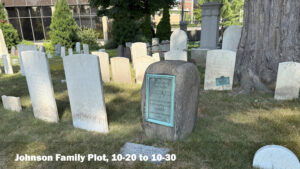
As you exit the graveyard through the gate to the driveway, the Mills Family Plot can be seen on the right. The oldest of the markers in this plot are the eight sandstone markers lined up near the corner of the “1776 On The Green” building. Included among these are Timothy Mills and his wife Phebe Mills. Timothy was a farmer and tanner by trade. The home of Timothy and Phebe on Mills Street, which once was considered the edge of town, is the oldest home remaining in Morristown. Timothy, who served in the Morris County Militia during the Revolution, was one of the early Elders of the Presbyterian Church, being ordained on November 6, 1761.
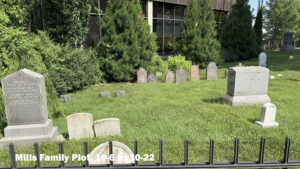
The grave stones seen in the graveyard probably tell only half the story. Unmarked are the graves of many soldiers interred in one or more mass graves, who died during the outbreak of small pox in 1777. In addition, the Bill of Mortality recording deaths in the Presbyterian & Baptist Congregations between 1768 and 1807 reveals the names of over 1400 people. Fully half of that number probably were interred here without ever having a marker placed.
